Pandelis Kourtessis
Near-Field Beamforming for Stacked Intelligent Metasurfaces-assisted MIMO Networks
Aug 03, 2024


Abstract:Stacked intelligent metasurfaces (SIMs) have recently gained significant interest since they enable precoding in the wave domain that comes with increased processing capability and reduced energy consumption. The study of SIMs and high frequency propagation make the study of the performance in the near field of crucial importance. Hence, in this work, we focus on SIM-assisted multiuser multiple-input multiple-output (MIMO) systems operating in the near field region. To this end, we formulate the weighted sum rate maximisation problem in terms of the transmit power and the phase shifts of the SIM. By applying a block coordinate descent (BCD)-relied algorithm, numerical results show the enhanced performance of the SIM in the near field with respect to the far field.
Achievable Rate Optimization for Large Stacked Intelligent Metasurfaces Based on Statistical CSI
May 29, 2024



Abstract:Stacked intelligent metasurface (SIM) is an emerging design that consists of multiple layers of metasurfaces. A SIM enables holographic multiple-input multiple-output (HMIMO) precoding in the wave domain, which results in the reduction of energy consumption and hardware cost. On the ground of multiuser beamforming, this letter focuses on the downlink achievable rate and its maximization. Contrary to previous works on multiuser SIM, we consider statistical channel state information (CSI) as opposed to instantaneous CSI to overcome challenges such as large overhead. Also, we examine the performance of large surfaces. We apply an alternating optimization (AO) algorithm regarding the phases of the SIM and the allocated transmit power. Simulations illustrate the performance of the considered large SIM-assisted design as well as the comparison between different CSI considerations.
STAR-RIS-Assisted Communication Radar Coexistence: Analysis and Optimization
Apr 25, 2024



Abstract:Integrated sensing and communication (ISAC) is expected to play a prominent role among emerging technologies in future wireless communications. In particular, a communication radar coexistence system is degraded significantly by mutual interference. In this work, given the advantages of promising reconfigurable intelligent surface (RIS), we propose a simultaneously transmitting and reflecting RIS (STAR-RIS)-assisted radar coexistence system where a STAR-RIS is introduced to improve the communication performance while suppressing the mutual interference and providing full space coverage. Based on the realistic conditions of correlated fading, and the presence of multiple user equipments (UEs) at both sides of the RIS, we derive the achievable rates at the radar and the communication receiver side in closed forms in terms of statistical channel state information (CSI). Next, we perform alternating optimization (AO) for optimizing the STAR-RIS and the radar beamforming. Regarding the former, we optimize the amplitudes and phase shifts of the STAR-RIS through a projected gradient ascent algorithm (PGAM) simultaneously with respect to the amplitudes and phase shifts of the surface for both energy splitting (ES) and mode switching (MS) operation protocols. The proposed optimization saves enough overhead since it can be performed every several coherence intervals. This property is particularly beneficial compared to reflecting-only RIS because a STAR-RIS includes the double number of variables, which require increased overhead. Finally, simulation results illustrate how the proposed architecture outperforms the conventional RIS counterpart, and show how the various parameters affect the performance. Moreover, a benchmark full instantaneous CSI (I-CSI) based design is provided and shown to result in higher sum-rate but also in large overhead associated with complexity.
Performance of Double-Stacked Intelligent Metasurface-Assisted Multiuser Massive MIMO Communications in the Wave Domain
Feb 26, 2024



Abstract:Although reconfigurable intelligent surface (RIS) is a promising technology for shaping the propagation environment, it consists of a single-layer structure within inherent limitations regarding the number of beam steering patterns. Based on the recently revolutionary technology, denoted as stacked intelligent metasurface (SIM), we propose its implementation not only on the base station (BS) side in a massive multiple-input multiple-output (mMIMO) setup but also in the intermediate space between the base station and the users to adjust the environment further as needed. For the sake of convenience, we call the former BS SIM (BSIM), and the latter channel SIM (CSIM). Hence, we achieve wave-based combining at the BS and wave-based configuration at the intermediate space. Specifically, we propose a channel estimation method with reduced overhead, being crucial for SIMassisted communications. Next, we derive the uplink sum spectral efficiency (SE) in closed form in terms of statistical channel state information (CSI). Notably, we optimize the phase shifts of both BSIM and CSIM simultaneously by using the projected gradient ascent method (PGAM). Compared to previous works on SIMs, we study the uplink transmission, a mMIMO setup, channel estimation in a single phase, a second SIM at the intermediate space, and simultaneous optimization of the two SIMs. Simulation results show the impact of various parameters on the sum SE, and demonstrate the superiority of our optimization approach compared to the alternating optimization (AO) method.
Two-Timescale Design for Active STAR-RIS Aided Massive MIMO Systems
Feb 15, 2024Abstract:Simultaneously transmitting and reflecting \textcolor{black}{reconfigurable intelligent surface} (STAR-RIS) is a promising implementation of RIS-assisted systems that enables full-space coverage. However, STAR-RIS as well as conventional RIS suffer from the double-fading effect. Thus, in this paper, we propose the marriage of active RIS and STAR-RIS, denoted as ASTARS for massive multiple-input multiple-output (mMIMO) systems, and we focus on the energy splitting (ES) and mode switching (MS) protocols. Compared to prior literature, we consider the impact of correlated fading, and we rely our analysis on the two timescale protocol, being dependent on statistical channel state information (CSI). On this ground, we propose a channel estimation method for ASTARS with reduced overhead that accounts for its architecture. Next, we derive a \textcolor{black}{closed-form expression} for the achievable sum-rate for both types of users in the transmission and reflection regions in a unified approach with significant practical advantages such as reduced complexity and overhead, which result in a lower number of required iterations for convergence compared to an alternating optimization (AO) approach. Notably, we maximize simultaneously the amplitudes, the phase shifts, and the active amplifying coefficients of the ASTARS by applying the projected gradient ascent method (PGAM). Remarkably, the proposed optimization can be executed at every several coherence intervals that reduces the processing burden considerably. Simulations corroborate the analytical results, provide insight into the effects of fundamental variables on the sum achievable SE, and present the superiority of 16 ASTARS compared to passive STAR-RIS for a practical number of surface elements.
Near-Field Terahertz Communications: Model-Based and Model-Free Channel Estimation
Feb 09, 2023



Abstract:Terahertz (THz) band is expected to be one of the key enabling technologies of the sixth generation (6G) wireless networks because of its abundant available bandwidth and very narrow beam width. Due to high frequency operations, electrically small array apertures are employed, and the signal wavefront becomes spherical in the near-field. Therefore, near-field signal model should be considered for channel acquisition in THz systems. Unlike prior works which mostly ignore the impact of near-field beam-split (NB) and consider either narrowband scenario or far-field models, this paper introduces both a model-based and a model-free techniques for wideband THz channel estimation in the presence of NB. The model-based approach is based on orthogonal matching pursuit (OMP) algorithm, for which we design an NB-aware dictionary. The key idea is to exploit the angular and range deviations due to the NB. We then employ the OMP algorithm, which accounts for the deviations thereby ipso facto mitigating the effect of NB. We further introduce a federated learning (FL)-based approach as a model-free solution for channel estimation in a multi-user scenario to achieve reduced complexity and training overhead. Through numerical simulations, we demonstrate the effectiveness of the proposed channel estimation techniques for wideband THz systems in comparison with the existing state-of-the-art techniques.
Terahertz-Band Channel and Beam Split Estimation via Array Perturbation Model
Aug 13, 2022
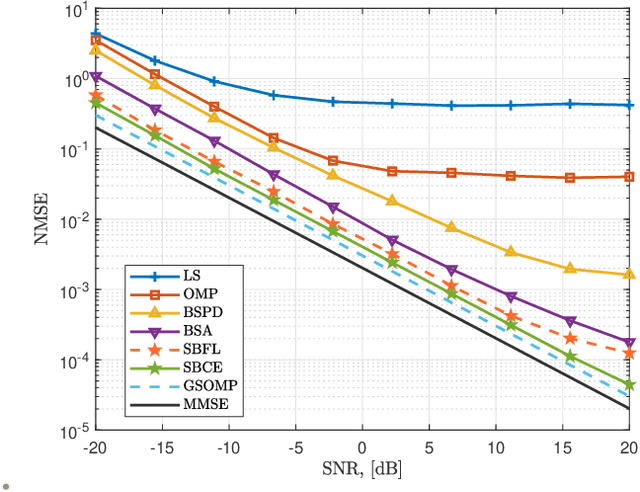
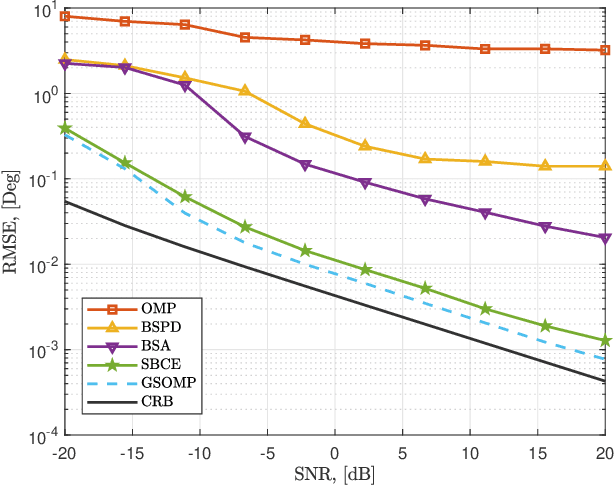
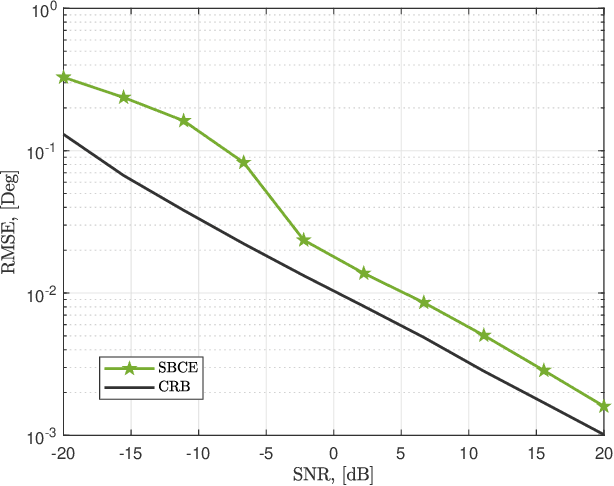
Abstract:For the demonstration of ultra-wideband bandwidth and pencil-beamforming, the terahertz (THz)-band has been envisioned as one of the key enabling technologies for the sixth generation networks. However, the acquisition of the THz channel entails several unique challenges such as severe path loss and beam-split. Prior works usually employ ultra-massive arrays and additional hardware components comprised of time-delayers to compensate for these loses. In order to provide a cost-effective solution, this paper introduces a sparse-Bayesian-learning (SBL) technique for joint channel and beam-split estimation. Specifically, we first model the beam-split as an array perturbation inspired from array signal processing. Next, a low-complexity approach is developed by exploiting the line-of-sight-dominant feature of THz channel to reduce the computational complexity involved in the proposed SBL technique for channel estimation (SBCE). Additionally, based on federated-learning, we implement a model-free technique to the proposed model-based SBCE solution. Further to that, we examine the near-field considerations of THz channel, and introduce the range-dependent near-field beam-split. The theoretical performance bounds, i.e., Cram\'er-Rao lower bounds, are derived for near- and far-field parameters, e.g., user directions, ranges and beam-split, and several numerical experiments are conducted. Numerical simulations demonstrate that SBCE outperforms the existing approaches and exhibits lower hardware cost.
Coverage Probability of STAR-RIS assisted Massive MIMO systems with Correlation and Phase Errors
May 31, 2022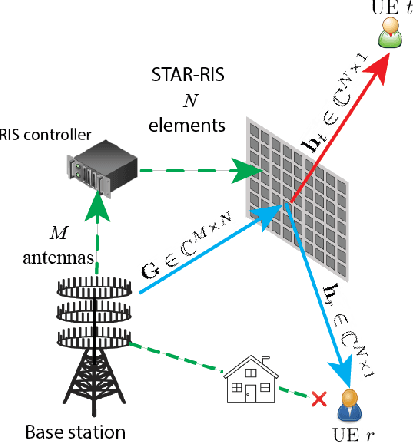
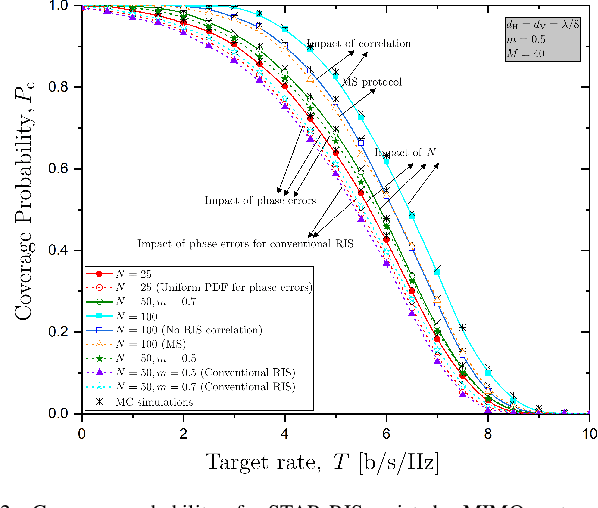
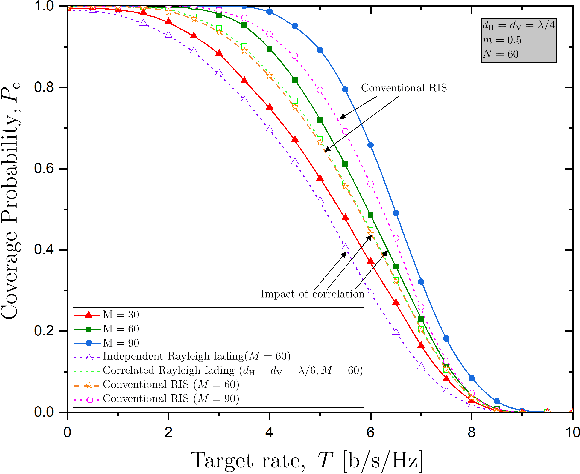
Abstract:In this paper, we investigate a simultaneous transmitting and reflecting reconfigurable intelligent surface (STAR-RIS) assisting a massive multiple-input multiple-output (mMIMO) system. In particular, we derive a closed-form expression for the coverage probability of a STAR-RIS assisted mMIMO system while accounting for correlated fading and phase-shift errors. Notably, the phase configuration takes place at every several coherence intervals by optimizing the coverage probability since the latter depends on statistical channel state information (CSI) in terms of large-scale statistics. As a result, we achieve a reduced complexity and overhead for the optimization of passive beamforming, which are increased in the case of STAR-RIS networks with instantaneous CSI. Numerical results corroborate our analysis, shed light on interesting properties such as the impact of the number of RIS elements and the effect of phase errors, along with affirming the superiority of STAR-RIS against reflective-only RIS.
 Add to Chrome
Add to Chrome Add to Firefox
Add to Firefox Add to Edge
Add to Edge